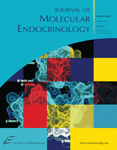| HOME | HELP | FEEDBACK | SUBSCRIPTIONS | ARCHIVE | SEARCH | TABLE OF CONTENTS |
|
|
||||||||
Introduction: Somatostatin is a peptide widely distributed in both the central nervous system (CNS) and peripheral tissues. It is found as two bioactive peptides of 14 and 28 amino acids, the latter being an N-terminal-extended form (Reichlin 1983a).
The name somatostatin comes from its initial discovery as an inhibitor of growth hormone (GH) release from anterior pituitary cells (Brazeau et al. 1973). Since then, numerous other physiological activities of somatostatin have been discovered associated with differing peptide and receptor localization (Reichlin 1983a,b). Besides GH, somatostatin is also able to inhibit secretion of prolactin (PRL) and thyroid-stimulating hormone (TSH) (Reichlin 1983a). In the CNS, the highest somatostatin concentrations have been detected in the hypothalamus in the tuberoinfundibular neurons where, acting as a neurohormone, the peptide regulates the hypothalamic-hypophyseal axis (Schettini 1991). Somatostatin-containing neurons are also present in many other areas of the brain, such as the cerebral cortex,
This article has been cited by other articles:
 |
F. Barbieri, A. Pattarozzi, M. Gatti, C. Aiello, A. Quintero, G. Lunardi, A. Bajetto, A. Ferrari, M. D. Culler, and T. Florio Differential efficacy of SSTR1, -2, and -5 agonists in the inhibition of C6 glioma growth in nude mice Am J Physiol Endocrinol Metab, November 1, 2009; 297(5): E1078 - E1088. [Abstract] [Full Text] [PDF] |
||||
 |
F. P. Leu, M. Nandi, and C. Niu The Effect of Transforming Growth Factor {beta} on Human Neuroendocrine Tumor BON Cell Proliferation and Differentiation Is Mediated through Somatostatin Signaling Mol. Cancer Res., June 1, 2008; 6(6): 1029 - 1042. [Abstract] [Full Text] [PDF] |
||||
 |
F. Barbieri, A. Bajetto, C. Porcile, A. Pattarozzi, G. Schettini, and T. Florio Role of stromal cell-derived factor 1 (SDF1/CXCL12) in regulating anterior pituitary function J. Mol. Endocrinol., March 1, 2007; 38(3): 383 - 389. [Abstract] [Full Text] [PDF] |
||||
 |
C. Hernandez, E. Carrasco, R. Casamitjana, R. Deulofeu, J. Garcia-Arumi, and R. Simo Somatostatin Molecular Variants in the Vitreous Fluid: A comparative study between diabetic patients with proliferative diabetic retinopathy and nondiabetic control subjects Diabetes Care, August 1, 2005; 28(8): 1941 - 1947. [Abstract] [Full Text] [PDF] |
||||
 |
S. Arena, A. Pattarozzi, A. Corsaro, G. Schettini, and T. Florio Somatostatin Receptor Subtype-Dependent Regulation of Nitric Oxide Release: Involvement of Different Intracellular Pathways Mol. Endocrinol., January 1, 2005; 19(1): 255 - 267. [Abstract] [Full Text] [PDF] |
||||
 |
A. Massa, F. Barbieri, C. Aiello, S. Arena, A. Pattarozzi, P. Pirani, A. Corsaro, R. Iuliano, A. Fusco, G. Zona, et al. The Expression of the Phosphotyrosine Phosphatase DEP-1/PTP{eta} Dictates the Responsivity of Glioma Cells to Somatostatin Inhibition of Cell Proliferation J. Biol. Chem., July 9, 2004; 279(28): 29004 - 29012. [Abstract] [Full Text] [PDF] |
||||
 |
E. Ludvigsen, R. Olsson, M. Stridsberg, E. T. Janson, and S. Sandler Expression and Distribution of Somatostatin Receptor Subtypes in the Pancreatic Islets of Mice and Rats J. Histochem. Cytochem., March 1, 2004; 52(3): 391 - 400. [Abstract] [Full Text] [PDF] |
||||
 |
T. Florio, M. Morini, V. Villa, S. Arena, A. Corsaro, S. Thellung, M. D. Culler, U. Pfeffer, D. M. Noonan, G. Schettini, et al. Somatostatin Inhibits Tumor Angiogenesis and Growth via Somatostatin Receptor-3-Mediated Regulation of Endothelial Nitric Oxide Synthase and Mitogen-Activated Protein Kinase Activities Endocrinology, April 1, 2003; 144(4): 1574 - 1584. [Abstract] [Full Text] [PDF] |
||||
 |
S. B. Curtis, J. Hewitt, S. Yakubovitz, A. Anzarut, Y. N. Hsiang, and A. M. J. Buchan Somatostatin receptor subtype expression and function in human vascular tissue Am J Physiol Heart Circ Physiol, June 1, 2000; 278(6): H1815 - H1822. [Abstract] [Full Text] [PDF] |
||||
 |
A. ALBINI, T. FLORIO, D. GIUNCIUGLIO, L. MASIELLO, S. CARLONE, A. CORSARO, S. THELLUNG, T. CAI, D. M. NOONAN, and G. SCHETTINI Somatostatin controls Kaposi's sarcoma tumor growth through inhibition of angiogenesis FASEB J, April 1, 1999; 13(6): 647 - 655. [Abstract] [Full Text] |
||||
 |
T. Florio, A. Scorziello, S. Thellung, S. Salzano, M. T. Berlingieri, A. Fusco, and G. Schettini Oncogene Transformation of PC Cl3 Clonal Thyroid Cell Line Induces an Autonomous Pattern of Proliferation That Correlates with a Loss of Basal and Stimulated Phosphotyrosine Phosphatase Activity Endocrinology, September 1, 1997; 138(9): 3756 - 3763. [Abstract] [Full Text] [PDF] |
||||
| HOME | HELP | FEEDBACK | SUBSCRIPTIONS | ARCHIVE | SEARCH | TABLE OF CONTENTS |